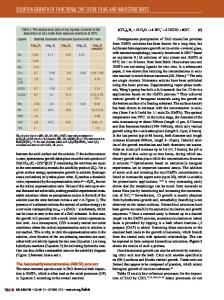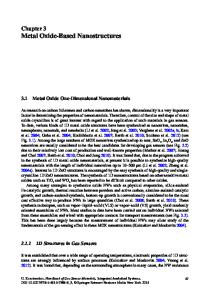Vanadium Oxide Nanostructures: Growth, Characterization and Applications
- PDF / 396,670 Bytes
- 5 Pages / 612 x 792 pts (letter) Page_size
- 86 Downloads / 373 Views
0900-O13-09.1
Vanadium Oxide Nanostructures: Growth, Characterization and Applications Sanjay Mathur*, Thomas Rügamer Nanocrystalline Materials and Thin Film Systems Division, Leibniz-Institute of New Materials D-66041 Saarbruecken, Germany ABSTRACT Vanadium oxide nanostructures (V2O5 and VO2) were obtained by chemical vapor deposition of the alkoxide precursor [VO(OPri)3]. The nanomaterials were studied with respect to their morphological features (HR-SEM) and phase structure (XRD) followed by characterization as resisitive-type gas sensors. Given the high surface area, vanadium oxide (VOx) nanostructures show significant sensor response via resistance change upon reaction induced by carbon monoxide and desorption of adsorbed oxygen at 400 °C. Tin-doped VOx showed enhanced sensitivity of the films which suggests a higher number of active sensing sites or alternations in the intrinsic electrical properties of VOx by addition of SnO2 as dopant. INTRODUCTION Vanadium oxides display interesting material properties such as thermochromic and electrochromic behavior as well as catalysts for reduction processes. VOx nanostructured materials have been prepared by different techniques such as wet chemical routes1-6 and film deposition procedures.7-9 The potential of vanadium compounds for technical applications arises from the specific electron configurations of vanadium atoms giving them an ability to show physical transition induced from environmental influences (e.g. temperature, current and gas concentration). Vanadium oxides with different valence states (from –1 to +5) are known, the two main phases being vanadium pentaoxide (V2O5) and vanadium dioxide (VO2) which are widely used for technical applications.8,10-13 In the present study, investigations on the gas phase synthesis of vanadium oxide nanostructures and their use as gas sensitive materials are reported. The sensitivity of VOx phases towards carbon monoxide (CO) and the influence of dopants on the sensor response have also been examinated. EXPERIMENTAL DETAILS Vanadium tri-isopropoxide (98%, STREM) was used as molecular source for the deposition of vanadium oxide films. A cold-wall horizontal CVD system operating under reduced pressure (10-6 Torr) was used for the experimental procedures. The substrates (Silicon and Al2O3) were placed on an inductively heated graphite susceptor (500 °C). A precursor heating was not necessary, as under the described experimental conditions the vapor pressure of [VO(OPri)3] was adequately high for the deposition process. The surface doping with the precursor [Sn(OtBu)4] was performed in the same reactor at 600 °C (deposition time: 10 seconds at precursor temperature 115 °C). To avoid transformation reactions during the gas sensing tests the as-deposited vanadium oxide films were annealed at atmosphere in a laboratory oven
0900-O13-09.2
(450 °C, 30 minutes). Surface morphology and elemental distribution were analyzed with a JEOL scanning electron microscope (JSM-6400F) coupled with an Energy Dispersive X-Ray facility. The pha
Data Loading...










